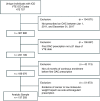Direct oral anticoagulants and warfarin for venous thromboembolism treatment: Trends from 2012 to 2017
- PMID: 31624786
- PMCID: PMC6782014
- DOI: 10.1002/rth2.12222
Direct oral anticoagulants and warfarin for venous thromboembolism treatment: Trends from 2012 to 2017
Abstract
Background: Direct oral anticoagulants (DOACs), namely rivaroxaban, apixaban, dabigatran, and edoxaban, are now included together with warfarin as standards of care for the primary treatment of venous thromboembolism (VTE). The extent to which the DOACs have been adopted since receiving US Food and Drug Administration (FDA) approval is unknown.
Objective: To document temporal trends in oral anticoagulant (OAC) prescriptions among anticoagulant-naïve patients initiating OACs for VTE primary treatment in the United States and to report participant characteristics by OAC prescribed for the year 2017.
Methods: MarketScan databases for years 2012 through 2017 were used to identify VTE cases and comorbidities using International Classification of Diseases codes and prescriptions for OACs via outpatient pharmaceutical claims data.
Results: The 137 203 VTE cases were on average (± standard deviation) 56.7 ± 16.0 years old and 49.9% female. Warfarin was prescribed to 98.7% of VTE patients receiving an OAC in quarter 1 (January through March) of 2012. By quarter 4 (October through December) of 2017, warfarin was prescribed to 17.5%, while rivaroxaban was prescribed to 42.7%, apixaban to 38.6%, dabigatran to 1.3%, and edoxaban to <0.1%. In 2017, the comorbidity burden was highest among patients prescribed warfarin, intermediate among patients prescribed apixaban, and lowest among patients prescribed rivaroxaban.
Conclusions: Rivaroxaban and apixaban use to treat VTE has increased dramatically since receiving FDA approval, whereas warfarin use has plummeted. Dabigatran and edoxaban are infrequently prescribed. Given widespread usage of rivaroxaban and apixaban, there is a need for continued monitoring of the comparative effectiveness of these OAC therapies in real-world settings.
Keywords: apixaban; direct oral anticoagulants; prescription trends; rivaroxaban; venous thromboembolism; warfarin.
© 2019 The Authors. Research and Practice in Thrombosis and Haemostasis published by Wiley Periodicals, Inc on behalf of International Society on Thrombosis and Haemostasis.
Conflict of interest statement
The authors report nothing to disclose.
Figures
References
-
- Schulman S, Kearon C, Kakkar AK, Mismetti P, Schellong S, Eriksson H, et al. Dabigatran versus warfarin in the treatment of acute venous thromboembolism. N Engl J Med. 2009;361:2342–52. - PubMed
-
- Einstein Investigators , Bauersachs R, Berkowitz SD, Brenner B, Buller HR, Decousus H, Gallus AS, et al. Oral rivaroxaban for symptomatic venous thromboembolism. N Engl J Med. 2010;363: 2499–510. - PubMed
-
- Buller HR, Decousus H, Grosso MA, Mercuri M, Middeldorp S, Prins MH, et al. Edoxaban versus warfarin for the treatment of symptomatic venous thromboembolism. N Engl J Med. 2013;369:1406–15. - PubMed
-
- Agnelli G, Buller HR, Cohen A, Curto M, Gallus AS, Johnson M, et al. Oral apixaban for the treatment of acute venous thromboembolism. N Engl J Med. 2013;369:799–808. - PubMed
-
- Schulman S, Kakkar AK, Goldhaber SZ, Schellong S, Eriksson H, Mismetti P, et al. Treatment of acute venous thromboembolism with dabigatran or warfarin and pooled analysis. Circulation. 2014;129:764–72. - PubMed
Grants and funding
LinkOut - more resources
Full Text Sources



